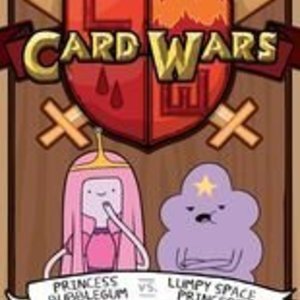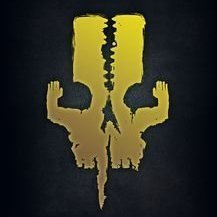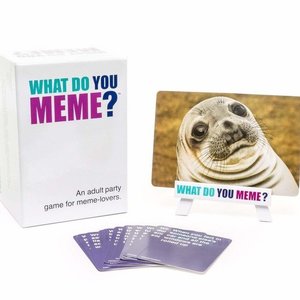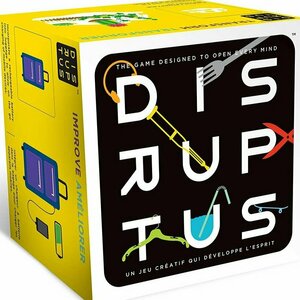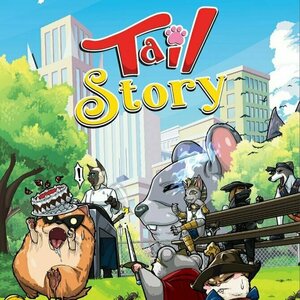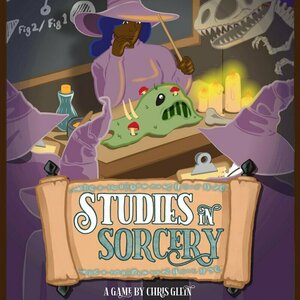Search
Search results
Paul Kellett (118 KP) rated The 7th Continent in Tabletop Games
Jun 9, 2019
Great art, map looks brilliant as it builds up as you explore (2 more)
Massive amount of gameplay
Great open world adventure
Roguelike - could be frustrating to have to restart especially on the longer curses (1 more)
A lot of cards, sorting them after a game is a bit of a faff
A Cool Adventure Survival game
7th Continent is an amazing and ambitious adventure / exploration game that is a lot more challenging than it appears.
On the surface, it looks like a card version of a choose your own adventure book, exploring and revealing a whole island as you find clues to lift a curse.
When you start playing however, you reveal a very tight card management and action optimization game that can be very unforgiving. This is both a great thing or a frustrating one depending on your view.
If you just want a light exploration game more like a CYOA book, or struggle finding card combos and optimal actions, this game might not be for you.
However, if you want a deeper game that rewards careful planning and finding the synergy between cards, 7th Continent is a rewarding experience.
The premise is simple - explore the island and try to find the right clues to lift a curse, one of several to choose from.
You start with an action deck of 35+ cards which also functions as your party's health. Everything you do requires you to discard cards from the deck. There is a big push your luck element here as every action requires a certain number of stars in order to succeed and every action card contains a varying number of stars. Do you play safe and draw more cards to minimise risk but drain more health or do you draw less and hope you succeed.
Every time you draw action cards, you can choose one to keep in your hand. These can be skills to help you control the deck or items you can build to make exploration and encounters easier.
You will find hunting spots along the way where you might find food to eat and replenish your action deck by returning cards from the discard pile but be warned, hunting also has it's own risks.
The action deck also contains 6 curse cards. These do nothing initially except reduce the chance of succeeding an encounter but, once all your action cards are discarded, you shuffle the discard pile and start drawing from that. If you ever draw a curse card from the discard, it's game over.
This is where the meat of the game is. You need to balance drawing cards and exploring the island with finding beneficial combos and cunning tricks to replenish the action deck. You won't be able to investigate every nook and cranny on the island in one game but, because of the roguelike nature, while you don't carry over any items between games, you can use your knowledge of the island to make your progress quicker. The more you play, the more familiar you get with the island and you know where to go to hunt, what things are worth looking at and what you should avoid.
The curses themselves are varied and play anywhere from 3 to 30 hours! This is great as it means there is a ton of play time but also a point of frustration as having to restart from the beginning after getting 10 hours into a curse can really put people off.
On the whole, I love it. 7th Continent really captures the feel of Jules Verne, HG Wells and that era of fiction. The way the map cards align seamlessly to reveal a complete landscape looks fantastic on the table and I enjoy the old school option of drawing maps and taking notes as I play.
I certainly recommend giving this game a try if you can.
On the surface, it looks like a card version of a choose your own adventure book, exploring and revealing a whole island as you find clues to lift a curse.
When you start playing however, you reveal a very tight card management and action optimization game that can be very unforgiving. This is both a great thing or a frustrating one depending on your view.
If you just want a light exploration game more like a CYOA book, or struggle finding card combos and optimal actions, this game might not be for you.
However, if you want a deeper game that rewards careful planning and finding the synergy between cards, 7th Continent is a rewarding experience.
The premise is simple - explore the island and try to find the right clues to lift a curse, one of several to choose from.
You start with an action deck of 35+ cards which also functions as your party's health. Everything you do requires you to discard cards from the deck. There is a big push your luck element here as every action requires a certain number of stars in order to succeed and every action card contains a varying number of stars. Do you play safe and draw more cards to minimise risk but drain more health or do you draw less and hope you succeed.
Every time you draw action cards, you can choose one to keep in your hand. These can be skills to help you control the deck or items you can build to make exploration and encounters easier.
You will find hunting spots along the way where you might find food to eat and replenish your action deck by returning cards from the discard pile but be warned, hunting also has it's own risks.
The action deck also contains 6 curse cards. These do nothing initially except reduce the chance of succeeding an encounter but, once all your action cards are discarded, you shuffle the discard pile and start drawing from that. If you ever draw a curse card from the discard, it's game over.
This is where the meat of the game is. You need to balance drawing cards and exploring the island with finding beneficial combos and cunning tricks to replenish the action deck. You won't be able to investigate every nook and cranny on the island in one game but, because of the roguelike nature, while you don't carry over any items between games, you can use your knowledge of the island to make your progress quicker. The more you play, the more familiar you get with the island and you know where to go to hunt, what things are worth looking at and what you should avoid.
The curses themselves are varied and play anywhere from 3 to 30 hours! This is great as it means there is a ton of play time but also a point of frustration as having to restart from the beginning after getting 10 hours into a curse can really put people off.
On the whole, I love it. 7th Continent really captures the feel of Jules Verne, HG Wells and that era of fiction. The way the map cards align seamlessly to reveal a complete landscape looks fantastic on the table and I enjoy the old school option of drawing maps and taking notes as I play.
I certainly recommend giving this game a try if you can.
Caffeinated Fae (464 KP) created a post
May 30, 2019
Red Otter (340 KP) rated What Do You Meme? in Tabletop Games
Jun 10, 2019
InfernalNinja (49 KP) rated Distruptus in Tabletop Games
Jun 9, 2020 (Updated Jun 9, 2020)
Train your creative thinking muscles!
Distruptus is a game with a super simple premise: using the object(s) on the cards you draw, you either create a new object or improve it, then the players vote on the best one.
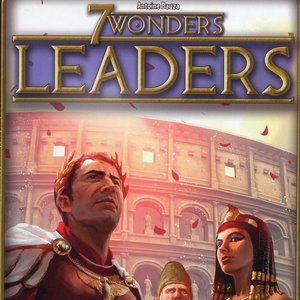
7 Wonders: Leaders Expansion
Tabletop Game
This expansion adds leader cards which can be recruited to aid a player's city. Each leader is based...

Port Royal
Tabletop Game
The merchant players in Port Royal, which won the Austrian Game Designers Competition under the...
Boardgames CardGames Pirategames
Purple Phoenix Games (2266 KP) rated Tail Story in Tabletop Games
Jul 1, 2020
The saying goes, “If you can dream it, you can achieve it.” I know there were points in my life when I wanted to be a rock star, a zookeeper, or even a professional mascot. But who says that dreams only apply to people? Our beloved pets can dream too! Haven’t you ever seen a sleeping pup, legs twitching from an imaginary chase? Or caught your cat prowling around, as if on a secret mission? What do animals dream about? Well, Tail Story allows you to create dreams and achieve the impossible with your chosen pet!
Disclaimer: We were provided with a preview copy of Tail Story for the purposes of this review. Some of the components pictured are not final, and will be addressed in production. Also, I do not intend to rehash the entire rulebook, but rather provide an overview of the rules and game flow. -L
Tail Story is a competitive card game in which players are racing to become the most memorable pet in history! How? By partaking in various events and gathering a total of 4 Achievements. Here’s how it works. To setup, each player takes a player mat, and randomly draws a Queue Card. Players then get to choose a Character card – a pet from either the Canine, Feline, or Rodent & Friends type. Shuffle the Event cards, deal 15 to each player, everyone draws 5 cards to their hand, and the game is ready to begin! The player who drew Queue Card 1 is the first player, and play continues in numerical order.
Each turn consists of 5 steps: Draw, Play, Bonus, Deck Check, and End of Turn. The first step is always to Draw 1 card from your deck. In the Play Step, you choose one action to perform. Each player has 2 Action Points (AP) per turn, and those are spent here in the Play Step. All Event cards require either 1 or 2 AP to play, and the other standard actions in the Play Step require either 0 or 1 AP to perform (Check out the Reference Cards pictured below to see the possible actions). After performing 1 action, you move to the Bonus Step, where a player may choose to activate a Bonus ability. The Deck Check step is next. All players count how many cards remain in their Draw piles. If all decks still have at least 1 card, you jump back to the Play Step and perform another action. If any deck is out of cards, that player reshuffles their discard pile, and places a card from their hand face-down on their player mat to signify that they have collected an Achievement. Even if another player collects an Achievement on your turn, play then returns to you, and you jump back to the Play Step again. The last step is the End of Turn – a player decides to be done and ends their turn, discarding their hand down to 5 cards. The game ends when a player has collected their 4th Achievement.
Here’s a neat twist though – whenever you play a card, any opponent can choose to play a Stop card to prevent you from performing that action! And then, if you have a Stop card too, you could play it to cancel out their Stop card. This twist adds a strategic and competitive element to the game that elevates it to the next level. There’s a fun little element of role-play too that encourages you to get into your animal character – I’ll leave that for you to discover on your own!
I know that seems like quite a lot, but once you get into the swing of things, Tail Story plays pretty quickly. One thing I particularly like about this game is that it requires a decent amount of strategy. Everyone is racing to get through their Draw decks and collect Achievements, while at the same time hindering the progress of their opponents. Are you willing to risk a valuable Stop card to cancel the action of an opponent and hope that they don’t play a Stop card back to you? Should you play a card that could activate your Bonus ability now or wait for your next action to pull a fast one over on your opponents? Your strategy has to be adjustable on the fly depending on what cards your opponents are playing. There is no single right strategy to win, and the riskiness makes the game more exciting and engaging.
Another thing I really like about Tail Story is that there are really only 4 different Event cards that can be played. Yes, the artwork may vary, but ultimately the actions are the same. They rely on key text and color coding to communicate their uses, and after a few rounds, recognizing those effects is easy. One thing I wish is that the reference cards had these effect explanation instead of only being listed in the rulebook. Just for a quick glance if you need a reminder instead of having to look back in the rules for the full text. The reference cards do have the Turn Steps and possible Actions on them, which are helpful – don’t get me wrong!
I would recommend Tail Story at the higher player counts for maximum enjoyment. With only 2 players, it feels like it drags on a bit because it is only a back-and-forth game. With 3-4 players, you have more opponents with which to interact, and playing cards against others doesn’t feel as targeted and keeps the game play more light-hearted than cut-throat.
Let’s talk about components. As I mentioned earlier, this is only a preview copy of the game, so some elements are still not finalized. The player mats are only paper right now, but I anticipate that they will be sturdier in final production. That being said, the information on the player mats is awesome. They provide enough information to understand where everything goes, while not being so wordy that they are confusing. I am excited to see what kind of color scheme they come up with for the player mats, to match the artwork of the cards. On to the cards – they are amazing. For starters, the cards are nice, sturdy, and thick. Definitely a game that will not easily succumb to bent corners or torn cards. The actual artwork of the cards is perfect. Each card is detailed, colorful, and appropriate for their respective card names. Probably the coolest part of the cards is that they all have a holographic finish on them. This really makes the artwork pop and makes you admire every card instead of just reading the text. That being said, the holographic finish makes the cards stick together a little more – not a huge detriment, but something to be aware of and careful with when drawing or playing cards! The game box is a cute little box with a magnet closure that is perfect for easy transportation.
Overall, I would say that I love Tail Story. It’s fun, fast-paced, strategic, and exciting. Being able to choose from 3 Character types (Canine, Feline, Rodent & Friends) gives you the opportunity to play a different game, with a different strategy, every time. With more plays, the special text of cards is engrained in your head, which means that it can play even faster and with no interruptions to check rules. It’s definitely a memorable game, and one that I can see myself pulling out often on game nights. I am excited to see this campaign launch, and for the sake of all animal dreams out there, you should check it out!
Disclaimer: We were provided with a preview copy of Tail Story for the purposes of this review. Some of the components pictured are not final, and will be addressed in production. Also, I do not intend to rehash the entire rulebook, but rather provide an overview of the rules and game flow. -L
Tail Story is a competitive card game in which players are racing to become the most memorable pet in history! How? By partaking in various events and gathering a total of 4 Achievements. Here’s how it works. To setup, each player takes a player mat, and randomly draws a Queue Card. Players then get to choose a Character card – a pet from either the Canine, Feline, or Rodent & Friends type. Shuffle the Event cards, deal 15 to each player, everyone draws 5 cards to their hand, and the game is ready to begin! The player who drew Queue Card 1 is the first player, and play continues in numerical order.
Each turn consists of 5 steps: Draw, Play, Bonus, Deck Check, and End of Turn. The first step is always to Draw 1 card from your deck. In the Play Step, you choose one action to perform. Each player has 2 Action Points (AP) per turn, and those are spent here in the Play Step. All Event cards require either 1 or 2 AP to play, and the other standard actions in the Play Step require either 0 or 1 AP to perform (Check out the Reference Cards pictured below to see the possible actions). After performing 1 action, you move to the Bonus Step, where a player may choose to activate a Bonus ability. The Deck Check step is next. All players count how many cards remain in their Draw piles. If all decks still have at least 1 card, you jump back to the Play Step and perform another action. If any deck is out of cards, that player reshuffles their discard pile, and places a card from their hand face-down on their player mat to signify that they have collected an Achievement. Even if another player collects an Achievement on your turn, play then returns to you, and you jump back to the Play Step again. The last step is the End of Turn – a player decides to be done and ends their turn, discarding their hand down to 5 cards. The game ends when a player has collected their 4th Achievement.
Here’s a neat twist though – whenever you play a card, any opponent can choose to play a Stop card to prevent you from performing that action! And then, if you have a Stop card too, you could play it to cancel out their Stop card. This twist adds a strategic and competitive element to the game that elevates it to the next level. There’s a fun little element of role-play too that encourages you to get into your animal character – I’ll leave that for you to discover on your own!
I know that seems like quite a lot, but once you get into the swing of things, Tail Story plays pretty quickly. One thing I particularly like about this game is that it requires a decent amount of strategy. Everyone is racing to get through their Draw decks and collect Achievements, while at the same time hindering the progress of their opponents. Are you willing to risk a valuable Stop card to cancel the action of an opponent and hope that they don’t play a Stop card back to you? Should you play a card that could activate your Bonus ability now or wait for your next action to pull a fast one over on your opponents? Your strategy has to be adjustable on the fly depending on what cards your opponents are playing. There is no single right strategy to win, and the riskiness makes the game more exciting and engaging.
Another thing I really like about Tail Story is that there are really only 4 different Event cards that can be played. Yes, the artwork may vary, but ultimately the actions are the same. They rely on key text and color coding to communicate their uses, and after a few rounds, recognizing those effects is easy. One thing I wish is that the reference cards had these effect explanation instead of only being listed in the rulebook. Just for a quick glance if you need a reminder instead of having to look back in the rules for the full text. The reference cards do have the Turn Steps and possible Actions on them, which are helpful – don’t get me wrong!
I would recommend Tail Story at the higher player counts for maximum enjoyment. With only 2 players, it feels like it drags on a bit because it is only a back-and-forth game. With 3-4 players, you have more opponents with which to interact, and playing cards against others doesn’t feel as targeted and keeps the game play more light-hearted than cut-throat.
Let’s talk about components. As I mentioned earlier, this is only a preview copy of the game, so some elements are still not finalized. The player mats are only paper right now, but I anticipate that they will be sturdier in final production. That being said, the information on the player mats is awesome. They provide enough information to understand where everything goes, while not being so wordy that they are confusing. I am excited to see what kind of color scheme they come up with for the player mats, to match the artwork of the cards. On to the cards – they are amazing. For starters, the cards are nice, sturdy, and thick. Definitely a game that will not easily succumb to bent corners or torn cards. The actual artwork of the cards is perfect. Each card is detailed, colorful, and appropriate for their respective card names. Probably the coolest part of the cards is that they all have a holographic finish on them. This really makes the artwork pop and makes you admire every card instead of just reading the text. That being said, the holographic finish makes the cards stick together a little more – not a huge detriment, but something to be aware of and careful with when drawing or playing cards! The game box is a cute little box with a magnet closure that is perfect for easy transportation.
Overall, I would say that I love Tail Story. It’s fun, fast-paced, strategic, and exciting. Being able to choose from 3 Character types (Canine, Feline, Rodent & Friends) gives you the opportunity to play a different game, with a different strategy, every time. With more plays, the special text of cards is engrained in your head, which means that it can play even faster and with no interruptions to check rules. It’s definitely a memorable game, and one that I can see myself pulling out often on game nights. I am excited to see this campaign launch, and for the sake of all animal dreams out there, you should check it out!
Purple Phoenix Games (2266 KP) rated Studies in Sorcery in Tabletop Games
Oct 6, 2020
We’re all nerds here, right? What was the best class the gang took in the Harry Potter series? Defense Against the Dark Arts of course! Learning spells to protect ones’ self (oneself? themselves??) from an onslaught of dark spells looked so fun in the movies. *DISCLAIMER: I have never read a Harry Potter book. I made it one chapter and couldn’t do it, but I have seen the movies several times.* In any case, what if you could learn the other side of these spells? The offensive ones? Well that would be cool right? What if you could get a full master’s degree in Dark Arts? Welcome to Studies in Sorcery.
Studies in Sorcery is a competitive card game that uses elements from other well-loved games and puts them with a wonderful theme and some very interesting card synergies. The game takes place over four school semesters (rounds) and each semester lasts four weeks (turns). Can you students complete your thesis using the research grants you are given, or will you fall flat to repeat the program again?
DISCLAIMER: We were provided a prototype copy of this game for the purposes of this preview. These are preview copy components, and the final components may be different from these shown. Also, it is not my intention to detail every rule in the game, but to give our readers an idea of how the game plays. You are invited to back the game on Kickstarter launching October 6, 2020, order from your FLGS, or purchase through any retailers stocking it after it is fulfilled. -T
To setup, separate each deck of cards into like piles (Levels 100, 200, and 300 of the projects, graveyard cards, candles, vials) and shuffle them. Lay out the moon phase cards and semester tracker, placing the tracker tokens (skull erasers in the prototype) on the start of the cards to begin play. Set out the candles and vials in their own piles, as well as the point modifier tokens. Deal project cards according to the semester tracker in a 3×2 pattern under the moon phase and semester tracker cards like is shown in the photo below. Initially the graveyard pile will have three stacks of two cards each face-down next to the draw pile. Each player receives a research grant card, two thesis cards to choose one from, and two 100-level project cards from which the player will choose one. Give the first-player token (in this prototype it’s a cute LEGO skeleton) to the player who last attended school, and the game may begin!
Each player will be resolving actions, committing materials to their projects, and using completed project abilities each moon phase (turn). The actions one may take are: Dig, Buy, Cram, and Project Action. When a player uses the Dig action, they are searching for materials. A player can look at the items in the first pile of graveyard cards and take all the contents. If they do not like them, draw a card from the draw deck and place it on the first pile. Continue this for the next pile, and if unsatisfied the player may draw the top card from the draw pile OR either a candle or vial from the supply of stock cards.
Buy actions allow a player to use any unwanted materials or research grant monies to purchase additional candles, vials, or project cards from the middle of the table. To Cram, players may commit up to two materials from their hand to a project by placing the materials under the project cards. Project Actions allow players to use actions printed on any of their completed project cards. These can be very powerful.
Once each player has taken one of these actions, move the tracker token on the moon phase card to the next icon – Commit. To commit materials to projects, simply place the cards under the selected project (exactly like players do with the Cram action). Once all players have completed their commits, they may complete any projects that have sufficient materials by discarding the used materials and flipping the project card to its opposite side earning the printed points at the end of the game.
Play continues in this fashion for four turns each semester and the game lasts four semesters. Therefore the game will last 16 turns total. Whomever earns the most points for combinations of completed thesis cards, completed projects, bonus point modifier tokens, and one point for each $8 worth of materials in hand will be named Valedictorian of their class and winner of Studies in Sorcery!
Components. Again, this is a prototype copy of the game, and I know some things will be different in the final version. However, what we were provided is a bunch of cards that have great art, are good quality, and are very easy to read and understand. The cute first player token will more than likely become a different component in the end, and the tracker tokens probably will be changed as well, but these are great bits to include in a game like this. The only negative I have about components is that I wish there was MORE color. Most of the cards are brown-heavy, and it’s completely fine, but I would love to have splashes of weird colors here and there. Overall, I am very pleased with the components in this game. Weird Giraffe Games always has great components in their prototypes AND final games.
It is probably no surprise that I love this game. The theme is wonderful, the wonky art is great, and it’s more thinky than one might imagine. The game play can be somewhat quick, or players can take excruciating amounts of time to think through their turns and chain together impressive actions. One thing remains constant – 16 turns to complete your thesis cards can be a huge undertaking. My first time playing I chose a thesis card worth 7 points (even though the rulebook advised me not to include those for the first play). I wasn’t even really that close to completing the thesis, but I may have with another two or three turns. But then again, that card is worth 7 points for a reason – it’s SUPPOSED to be difficult. My suggestion: take the rulebook’s advice and remove those thesis cards for the first play. Don’t try to be a hero.
Ahhhhhhh! I want to play it again right now just so I can attempt that thesis card again. But there are other thesis cards in the game. And other strategies to apply. And really, when you can’t wait to play a game, that’s a sign of a fantastic game for that specific gamer. Will this be a gem for everyone? I don’t know. It certainly works for me and my circle of gamers.
If you are a fan of the Harry Potter series (even though this is NOT a Harry Potter game) and need a thinky card game with that sort of fantasy classroom theme, or if your collection is begging for something new and quirky, or if you just love Weird Giraffe Games’ catalog and need every game they offer (I wouldn’t blame you), then you need to give Studies in Sorcery a look. Please consider backing it on Kickstarter launching October 6, 2020. I know my collection just got a lot cooler with this one.
Studies in Sorcery is a competitive card game that uses elements from other well-loved games and puts them with a wonderful theme and some very interesting card synergies. The game takes place over four school semesters (rounds) and each semester lasts four weeks (turns). Can you students complete your thesis using the research grants you are given, or will you fall flat to repeat the program again?
DISCLAIMER: We were provided a prototype copy of this game for the purposes of this preview. These are preview copy components, and the final components may be different from these shown. Also, it is not my intention to detail every rule in the game, but to give our readers an idea of how the game plays. You are invited to back the game on Kickstarter launching October 6, 2020, order from your FLGS, or purchase through any retailers stocking it after it is fulfilled. -T
To setup, separate each deck of cards into like piles (Levels 100, 200, and 300 of the projects, graveyard cards, candles, vials) and shuffle them. Lay out the moon phase cards and semester tracker, placing the tracker tokens (skull erasers in the prototype) on the start of the cards to begin play. Set out the candles and vials in their own piles, as well as the point modifier tokens. Deal project cards according to the semester tracker in a 3×2 pattern under the moon phase and semester tracker cards like is shown in the photo below. Initially the graveyard pile will have three stacks of two cards each face-down next to the draw pile. Each player receives a research grant card, two thesis cards to choose one from, and two 100-level project cards from which the player will choose one. Give the first-player token (in this prototype it’s a cute LEGO skeleton) to the player who last attended school, and the game may begin!
Each player will be resolving actions, committing materials to their projects, and using completed project abilities each moon phase (turn). The actions one may take are: Dig, Buy, Cram, and Project Action. When a player uses the Dig action, they are searching for materials. A player can look at the items in the first pile of graveyard cards and take all the contents. If they do not like them, draw a card from the draw deck and place it on the first pile. Continue this for the next pile, and if unsatisfied the player may draw the top card from the draw pile OR either a candle or vial from the supply of stock cards.
Buy actions allow a player to use any unwanted materials or research grant monies to purchase additional candles, vials, or project cards from the middle of the table. To Cram, players may commit up to two materials from their hand to a project by placing the materials under the project cards. Project Actions allow players to use actions printed on any of their completed project cards. These can be very powerful.
Once each player has taken one of these actions, move the tracker token on the moon phase card to the next icon – Commit. To commit materials to projects, simply place the cards under the selected project (exactly like players do with the Cram action). Once all players have completed their commits, they may complete any projects that have sufficient materials by discarding the used materials and flipping the project card to its opposite side earning the printed points at the end of the game.
Play continues in this fashion for four turns each semester and the game lasts four semesters. Therefore the game will last 16 turns total. Whomever earns the most points for combinations of completed thesis cards, completed projects, bonus point modifier tokens, and one point for each $8 worth of materials in hand will be named Valedictorian of their class and winner of Studies in Sorcery!
Components. Again, this is a prototype copy of the game, and I know some things will be different in the final version. However, what we were provided is a bunch of cards that have great art, are good quality, and are very easy to read and understand. The cute first player token will more than likely become a different component in the end, and the tracker tokens probably will be changed as well, but these are great bits to include in a game like this. The only negative I have about components is that I wish there was MORE color. Most of the cards are brown-heavy, and it’s completely fine, but I would love to have splashes of weird colors here and there. Overall, I am very pleased with the components in this game. Weird Giraffe Games always has great components in their prototypes AND final games.
It is probably no surprise that I love this game. The theme is wonderful, the wonky art is great, and it’s more thinky than one might imagine. The game play can be somewhat quick, or players can take excruciating amounts of time to think through their turns and chain together impressive actions. One thing remains constant – 16 turns to complete your thesis cards can be a huge undertaking. My first time playing I chose a thesis card worth 7 points (even though the rulebook advised me not to include those for the first play). I wasn’t even really that close to completing the thesis, but I may have with another two or three turns. But then again, that card is worth 7 points for a reason – it’s SUPPOSED to be difficult. My suggestion: take the rulebook’s advice and remove those thesis cards for the first play. Don’t try to be a hero.
Ahhhhhhh! I want to play it again right now just so I can attempt that thesis card again. But there are other thesis cards in the game. And other strategies to apply. And really, when you can’t wait to play a game, that’s a sign of a fantastic game for that specific gamer. Will this be a gem for everyone? I don’t know. It certainly works for me and my circle of gamers.
If you are a fan of the Harry Potter series (even though this is NOT a Harry Potter game) and need a thinky card game with that sort of fantasy classroom theme, or if your collection is begging for something new and quirky, or if you just love Weird Giraffe Games’ catalog and need every game they offer (I wouldn’t blame you), then you need to give Studies in Sorcery a look. Please consider backing it on Kickstarter launching October 6, 2020. I know my collection just got a lot cooler with this one.
